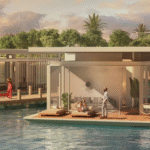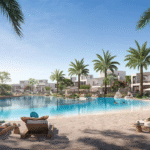Now Reading: Net-Zero Communities: The Future of Sustainable Living in the UAE
-
01
Net-Zero Communities: The Future of Sustainable Living in the UAE
Net-Zero Communities: The Future of Sustainable Living in the UAE

Table of Contents
The United Arab Emirates (UAE) is leading the charge in sustainable urban development with net-zero communities, designed to achieve zero carbon emissions through renewable energy, energy-efficient designs, and innovative technologies. Aligned with UAE Net Zero 2050, Dubai 2040 Urban Master Plan, and UAE Vision 2030, these communities integrate green building standards, smart systems, and circular economies to redefine eco-friendly living. In Dubai, Sharjah, and Abu Dhabi, projects like The Sustainable City, Sharjah Sustainable City, and Masdar City exemplify this vision, offering attractive investment opportunities despite Dubai’s predicted 15% real estate price correction in 2025.
This response details key net-zero communities, their features, investment potential, and comparisons with Dubai’s smart homes, providing actionable strategies for investors and residents seeking sustainable living in the UA
.
Key Net-Zero Communities in the UAE (2025)

- The Sustainable City – Dubai:
- Overview: Developed by SEE Holding, this 46-hectare community in Dubai features 500 villas, 89 apartments, and 3,000 residents, achieving net-zero energy since 2016, per thesustainablecity.ae.
- Features:
- 100% solar-powered with 10 MW rooftop panels, reducing electricity costs by 50%, per emiratesgbc.org.
- 100% wastewater recycling for irrigation, 40% water savings via smart systems, per ecomena.org.
- Urban farming produces 3,000 kg of organic vegetables annually, with biodomes and vertical farms, per thesustainablecity.ae.
- Car-free zones, EV charging stations, and 10 km of cycling tracks, per drivenproperties.com.
- Al Sa’fat Platinum-certified, with smart home automation, per 100keys.ae.
- Investment Potential: Villas (AED 2.5–5 million) offer 6–8% rental yields, 10–15% appreciation by 2026, per Tenco Homes. Resilient to 15% correction due to eco-premiums, per Colife.
- Completion: Fully operational, with expansions planned for 2025, per thesustainablecity.ae.
- Sharjah Sustainable City (SSC) – Sharjah:
- Overview: A 7.2 million sq ft project by Shurooq and Diamond Developers in Al Rahmaniyah, with 1,250 villas (3–5 bedrooms, AED 1.8–3 million), targeting net-zero by Q2 2025, per sharjahsustainablecity.ae.
- Features:
- Rooftop solar panels, thermal-insulated walls, and smart grids cut energy use by 50%, per esgmena.com.
- 100% wastewater recycling, 85% waste diversion via composting, and a planned biogas plant, per Wikipedia.
- Five biodomes yield 10,000 kg of organic produce annually, per zawya.com.
- EV shuttles, 11.8 km jogging tracks, and AI-driven emissions monitoring, per thesustainablecity.com.
- LEED-certified, with no service fees for five years, per selecthouse.co.
- Investment Potential: 5.06% ROI, 10–15% appreciation by 2026, AED 2.5 billion in sales by 2024, per sharjahsustainablecity.ae. Stable with Sharjah’s 7.5% economic growth, per esgmena.com.
- Completion: Phase 4 handover by Q2 2025, per cbnme.com.
- Masdar City – Abu Dhabi:
- Overview: A 6 sq km eco-city by Masdar, hosting 50,000 residents and 1,500 businesses by 2025, with apartments and villas from AED 1.5 million, per masdarcity.ae.
- Features:
- 10 MW solar plant, wind towers, and geothermal cooling reduce energy use by 40%, per aoshearman.com.
- Smart water systems save 30% of potable water, per ecomena.org.
- Driverless electric pods and 90% walkable design, per masdarcity.ae.
- Estidama Pearl 2 and LEED Platinum-certified buildings, including Siemens’ HQ, per emiratesgbc.org.
- Research hub with IRENA and Mohamed bin Zayed University of AI, per masdarcity.ae.
- Investment Potential: 5–7% yields, 12–15% appreciation by 2027, 24% sales growth (USD 26 billion in 2024), per invictaproperty.com. High demand from professionals, per economymiddleeast.com.
- Completion: Core phases complete, full build-out by 2025, per masdarcity.ae.
Features of UAE Net-Zero Communities

- Renewable Energy: Solar panels, wind, and geothermal systems achieve 100% clean energy, reducing costs by 40–50%, per emiratesgbc.org.
- Water Conservation: Wastewater recycling and smart irrigation save 30–40% of water, per ecomena.org.
- Waste Management: 85–90% waste diversion through recycling and composting, with biogas plants, per Wikipedia.
- Urban Farming: Biodomes and vertical farms produce 3,000–10,000 kg of organic food annually, per thesustainablecity.ae.
- Smart Technology: AI, IoT, and digital twins optimize energy, water, and emissions, per 100keys.ae.
- Mobility: EV charging, electric shuttles, and car-free zones reduce emissions by 20%, per drivenproperties.com.
- Certifications: LEED, Estidama, and Al Sa’fat ensure global sustainability standards, per emiratesgbc.org.
Investment Potential
- Market Context: Dubai faces a 15% price correction due to a 210,000-unit supply surge, but net-zero communities maintain 10–25% eco-premiums, per Fitch Ratings and Forbes. Sharjah and Abu Dhabi show stable 7.5% and 6.2% economic growth, per esgmena.com and invictaproperty.com.
- Pricing: Villas range from AED 1.8 million (SSC) to AED 5 million (Dubai); apartments start at AED 1.5 million (Masdar), vs. Dubai’s median AED 2,009/sq ft, per properstar.com.
- Rental Yields: 5–8%, with 13–18% rental growth in Dubai, 10% in Sharjah, and 20–31% in Abu Dhabi, per Colife and economymiddleeast.com.
- Capital Appreciation: 10–15% by 2026–2027, driven by sustainability demand and UAE’s 50,000 green jobs, per ecomena.org.
- Demand Drivers:
- Eco-Conscious Buyers: 30% of 2025 homebuyers prioritize sustainability, per PropTech Trends 2025.
- Tourism and Expats: 20.5 million tourists in Dubai, 1 million in Abu Dhabi, per Colife and gulfnews.com.
- Incentives: Golden Visa (AED 2 million+), 0% income/property tax, flexible payment plans, per bhomes.com.
- Market Sentiment: X posts praise net-zero communities for cost savings and eco-appeal, per @UAESustainability and @GreenDubai.
Comparison with Dubai’s Smart Homes
- Dubai Smart Homes:
- Features: Emaar’s Dubai Hills Estate and DAMAC Hills 2 integrate AI, IoT, and blockchain (apartments from AED 600,000, villas from AED 2.5 million), with smart security and wellness tech, per properties.emaar.com. Al Sa’fat Silver-compliant, per emiratesgbc.org.
- Investment: 5–9% yields, 8–12% appreciation, resilient in premium areas despite 15% correction, per DAMAC Properties. Driven by 20.5 million tourists, per Colife.
- Appeal: Tech-focused luxury, ideal for HNWIs and expats, with advanced PropTech, per drivenproperties.com.
- Challenges: Higher entry prices and correction risk in mid-market segments, per Fitch Ratings.
- Net-Zero Communities Advantages:
- Sustainability: Achieve full net-zero emissions vs. smart homes’ 20–30% energy savings, per thesustainablecity.ae and 100keys.ae.
- Cost Savings: 40–50% utility reductions and zero service fees (SSC) vs. 15–30% for smart homes, per esgmena.com and drivenproperties.com.
- Community Focus: Urban farming, car-free zones, and cohesive neighborhoods vs. smart homes’ individual focus, per zawya.com.
- Challenges: Less luxury appeal and slower tech adoption (e.g., limited blockchain in SSC/Masdar), per PropTech Trends 2025.
Investment Opportunities and Strategies
- Net-Zero Villas:
- Areas: The Sustainable City (Dubai), SSC (Sharjah), Masdar City (Abu Dhabi).
- Why Invest: 5–8% yields, 10–15% appreciation, 10–25% eco-premiums, per Forbes.
- Action: Explore via thesustainablecity.ae, sharjahsustainablecity.ae, or masdarcity.ae; use Bayut for listings, per Bayut.
- Off-Plan Net-Zero Apartments:
- Areas: Masdar City, SSC Phase 4.
- Why Invest: AED 1.5–1.8 million entry, 5–7% yields, 12–15% growth, per economymiddleeast.com.
- Action: Book via bayut.com or ACRES 2025, verify escrow with DLD/SRERD/ADREC, per valorisimo.com.
- Short-Term Eco-Rentals:
- Areas: The Sustainable City, Masdar City.
- Why Invest: 6–8% yields, 13–31% rental growth from tourism, per Colife and economymiddleeast.com.
- Action: List on Airbnb, ensure RERA compliance, per londondaily.news.
- Green Commercial Spaces:
- Areas: Masdar City (business hubs), The Sustainable City (retail).
- Why Invest: 7–9% yields, 20% occupancy growth, per invictaproperty.com.
- Action: Invest via keltandcorealty.com, confirm licensing, per keltandcorealty.com.
Challenges and Considerations
- Compliance Costs: KYC, AML, and 9% corporate tax via EmaraTax by March 31, 2025, cost AED 10,000–50,000, with AED 10,000 penalties, per Understanding UAE’s 15% Corporate Tax.
- Infrastructure Gaps: Sharjah and Abu Dhabi lag in public transport compared to Dubai, per mdpi.com.
- Investor Education: 20–30% need guidance on net-zero investments and certifications, per PropTech Trends 2025.
- Global Risks: Oil price volatility could impact funding for green projects, per topluxuryproperty.com.
Recommendations
- Investment Strategy: Target off-plan apartments in Masdar City or villas in SSC for 5–8% yields, using bayut.com.
- Compliance Check: Verify developer licensing and escrow via DLD , SRERD, or ADREC , per bhomes.com.
- Leverage Technology: Use 3D tours on thesustainablecity.ae or masdarcity.ae, explore listings on propertyfinder.ae, per zawya.com.
- Legal Support: Engage lawyers for KYC, wills, and tax compliance (AED 5,000–15,000), per Apex Capital.
- Tax Planning: Register via EmaraTax March 31, 2025, consult PwC Middle East, per Understanding UAE’s 15% Corporate Tax.
- Monitor Updates: Track trends via emiratesgbc.org, Emirates 24/7, and ACRES 2025, per cbnme.com.
watch more
read more: Smart Homes in Dubai: Integrating Technology for Enhanced Living






















